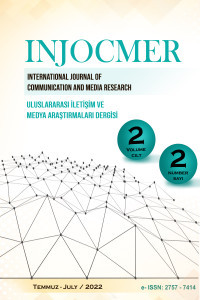YENİ MEDYA ETİĞİNDE NEREDE DURULMALI
Bu makale, yeni medya kullanıcılarına etik ile ilgili bir kapı açmayı amaçlar. Bunun için etik kavramının aslında tarihsel olarak ve doğasına uygun bir biçimde nasıl bir bütüncüllük sergilediğini ifade eder. Öncelikle sosyal bilimler alanında Kültürel Çalışmalar gibi bütüncül yaklaşımlar olduğuna değinir, ardından etik ve sosyal bilimlerin el ele yürüdüğünden bahseder. Sonrasında etiğin de aslında sosyal bilimlere benzer bir şekilde bütüncül görülmesi gerektiğini vurgular. Ardından günümüzde etik anlayışının yalnızca iş ahlakı gibi görülmeye başladığını ancak bunun etiğin aslından kopuk ve yine etiğin doğasına tamamen aykırı bir şekilde kısıtlanmış olduğuna değinir. Özellikle kanunen suç sayılmayan nahoş davranışların gelecekte yaşanmasını önlemek amacıyla herkesin anlayabileceği bir etik anlayış sunmanın gerekli olduğunu savunur. Sonrasında siyaset felsefesinde önemli bir isim olan Rawls’un adalet felsefesinde yer alan anahtar kavram olan cehalet örtüsünü bir metafor olarak etik içinde yeniden canlandırmanın mümkün ve en uygun yöntem olduğunu savunur. Bunun kullanıcılar açısından yeni medya etiği şeklinde örnek alınarak benimsenebileceğini ifade eder.
Anahtar Kelimeler:
Yeni medya, etik, bütünsel yeni medya etiği, Rawls, cehalet örtüsü
WHERE TO STAND IN NEW MEDIA ETHICS
This article aims to open the door to ethics to new media users. For this reason, it expresses how the concept of ethics actually exhibits a holism historically and in accordance with its nature. First of all, it mentions that there are holistic approaches such as Cultural Studies in the field of social sciences, then it mentions that ethics and social sciences go hand in hand. Afterwards, it emphasizes that ethics should be seen holistically, similar to social sciences. Then, it mentions that today the understanding of ethics has started to be seen as only business ethics, but this is detached from the essence of ethics and is restricted in an entirely contrary to the nature of ethics. In particular, it argues that it is necessary to present an ethical understanding that everyone can understand to prevent unpleasant actions in the future – even though those are not lawfully classified as crimes. Afterwards, it argues that it is a possible and most appropriate way to revive the veil of ignorance, which is the critical concept in the philosophy of justice of Rawls, an actual name in political philosophy, as a metaphor in ethics. It states that this metaphor can be adopted by taking the example of new media ethics for users.
Keywords:
Keywords: New media, ethics, wholistic new media ethics, Rawls, veil of ignorance,
___
- Berghel, H. (2018). Malice domestic: The Cambridge analytica dystopia. Computer, 51(05), 84-89.
- Braun, M. J. (1999). Media Ethics Education: A Comparison of Student Responses. Journal of Mass Media Ethics, 14(3), 171. doi:10.1207/S15327728JMME1403_4
- Bucholtz, I. (2019). “It Has to Be in One’s Head and Heart”: The Understanding of Journalism Ethics in Latvian Media. Journalism Studies. doi:10.1080/1461670X.2019.1664316
- Couldry, N., Pinchevski, A., & Madianou, M. (2013). Ethics of Media. Houndmills, Basingstoke, Hampshire: Palgrave Macmillan.
- Cram, I. (2002). Beyond Calcutt: The legal and extra-legal protection of privacy interests in England and Wales. In Media Ethics (pp. 97-110). Routledge.
- Dunwoody, S., & Konieczna, M. (2013). in Telling the Climate Change Story. Global media ethics: Problems and perspectives, 171.
- Dünyanın değişim ve aktivizm platformu. (n.d.). Change.org. Retrieved 2022, June 27 from https://www.change.org/
- Graham, G. (2002). Sex and violence in fact and fiction. In Media Ethics (pp. 152-164). Routledge.
- Ellis, A. (2002). Censorship and the media. In Media Ethics (pp. 165-178). Routledge.
- Hankins, J. (Ed.). (2007). The Cambridge companion to Renaissance philosophy. Cambridge University Press.
- Heiskala, R. (2018). For a holistic social science: the NACEVP model applied to the environment, gender and populism. Journal of Political Power, 11(3), 322-340.
- Jiang, S., & Ngien, A. (2020). The effects of Instagram use, social comparison, and self-esteem on social anxiety: A survey study in Singapore. Social Media+ Society, 6(2), 2056305120912488.
- Kieran, M. (2002). Objectivity, impartiality and good journalism. In Media ethics (pp. 23-36). Routledge.
- Kleinman, P. (2013). Philosophy 101: From Plato and Socrates to ethics and metaphysics, an essential primer on the history of thought. Simon and Schuster.
- Rao, S., & Wasserman, H. (Eds.). (2015). Media ethics and justice in the age of globalization. Springer.
- Rawls, J. (1971). A theory of justice (Original ed. ed.): Belknap Press.
- Rawls, J., & Herman, B. (2000). Lectures on the history of moral philosoph (2.bs. ed.): Harvard University.
- Ward, S. J. A. (2015). Radical Media Ethics: A Global Approach. Chichester, West Sussex, UK: Wiley-Blackwell.
- Ward, S. J. A., & Wasserman, H. (2015). Open Ethics. Journalism Studies, 16(6), 834-849. doi:10.1080/1461670X.2014.950882
- Wyatt, W. (2008). Being Aristotelian: Using Virtue Ethics in an Applied Media Ethics Course. In (Vol. 23, pp. 296-307).
- Başlangıç: 2021
- Yayıncı: Karabük Üniversitesi
